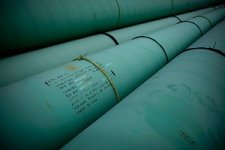Environmental Issues with the Keystone pipeline
Catcher Cuts The Road, an Iraq War veteran, leads a protest march to a sacred burial ground at the Standing Rock Indian Reservation in North Dakota, Sept. 9, 2016. A federal judge on Friday denied the Standing Rock Sioux Tribe's efforts to halt the construction of a pipeline skirting the northern edge of the reservation on Friday; on the same day, the government ordered a the pipeline company to pause its work.
Photograph by Alyssa Schukar, The New York Times, Redux
President Donald Trump signed executive orders early this week that restarted the effort to complete the Keystone XL pipeline across the Great Plains (see a map of the route) and the Dakota Access pipeline in the northern plains.
If the two pipeline projects that were halted during former President Barack Obama’s time in office begin moving forward again, here’s the impact they may have on the environment and people.
1. How the Pipelines May Affect Animals
The critically endangered whooping crane is at risk of flying into new power lines that would be constructed to keep oil pumping through the Keystone XL pipeline, the National Wildlife Federation has said. While the greater sage-grouse isn’t officially an endangered species, it has already lost some of its habitat, and the Keystone XL pipeline route is close enough to areas where grouse mate that noise from roads, pumping stations, and construction could impact the breeding success of this shy bird.
The Keystone XL pipeline route would go through most of the remaining locations of the swift fox, a tiny canid about the size of a house cat. The U.S. State Department’s Environmental Impact Report also said that some American burying beetles will be killed and their habitats also destroyed by the pipeline, though the agency added that a monitoring and habitat-restoration program would help mitigate losses and the species wouldn’t be seriously threatened.
There are nine threatened, endangered, and candidate species in the areas that the Dakota Access pipeline would run through, according to an environmental assessment by the U.S. Fish and Wildlife Service published in May 2016. The assessment concluded that the pipeline does not pose a specific threat to any of their habitats.










